Investigation of the Scale Factor Impact on the Results of Acoustic Emission Monitoring of the Steel Specimens Tension Process
Abstract
1. Introduction
2. Materials and Methods
3. Results
4. Discussion
5. Conclusions
- -
- The change in primary parameters of the recorded AE signals depending on the size of the developing crack during tensile testing of steel specimens with various thicknesses was assessed. It was established that an increase in the thickness of the controlled object leads to a steady change in the primary parameters of acoustic emission data—a rise in the AE signals amplitude (um) and the AE hits rate (Ń). The values of AE signals amplitude and AE hits rate recorded during the tension test of steel specimens with thickness t = 1 mm and t = 6 mm corresponded to the values (um = 89 dB; Ń = 27 hits/s) and (um = 100 dB; Ń = 38 hits/s) respectively. The greatest difference in the values of the primary AE parameters is observed at the initial stage of destruction—during a crack initiation in the stress concentrator (V-shape notch). We assume that this is due to the uneven crack development along the thickness in specimens of large thickness at the initial stage. In the case of thick samples, several cracks form at the initial stage of fracture, each of which is a separate AE source that increases the overall acoustic activity.
- -
- It was presented that the distribution parameters of the mean count frequency of AE signals depend on the specimen thickness. The parameter Np/τp can be used in the construction of analytical models for estimating the damage degree of the objects under study, which are invariant to the influence of the scale factor. For 30 KhGSA specimens, an empirical dependence of the quantile of the mean count frequency distribution of AE signals of level p = 0.8 on the specimen thickness t was obtained: (Np/τp)p = 0.8(t) = 0.04∙t(−0.45) + 0.16 (coefficient of determination R2 = 0.98).
- -
- It has been shown that an increase in the specimen thickness led to a significant increment of the cumulative energy of the registered AE signals EΣ(t) = −15.39∙t(−0.93) + 124.52, (coefficient of determination R2 = 0.96).
- -
- It has been assumed that the main factors affecting the influence of the scale effect are the overall increase in the deformable metal volume, as well as the more complex stress-strain state of the metal near the stress concentrator due to the transverse deformations present in specimens with large thicknesses. Using the DIC method, it was shown that with an increase in the specimen thickness, the strain value before failure rises, both the average strain before failure in the region near the V-shaped notch and the ultimate strain value at the fracture site. Since the plastically deformable metal is an AE source, the overall increase in its volume and the increase in the ultimate strain degree also explain the increased acoustic activity when testing thicker specimens.
- -
- The results obtained show that for a defined structural metal alloy there is an impact of the test object sizes on the AE parameters. This leads to the need to take into account the sizes of the control object, since this affects the classification of the danger degree of identified AE sources, as well as the values of the criteria for assessing the technical condition of the object. To develop a reliable method for assessing the state of the metallic object, invariant to the influence of the scale factor, the authors plan to conduct additional studies using artificial neural networks and regression analysis models.
Author Contributions
Funding
Institutional Review Board Statement
Informed Consent Statement
Acknowledgments
Conflicts of Interest
References
- Tang, J.; Wang, Y.; Li, J.; Wang, H.; Chen, G. In-situ monitoring and analysis of the pitting corrosion of carbon steel by acoustic emission. Appl. Sci. 2019, 9, 706. [Google Scholar] [CrossRef]
- Lukonge, A.; Cao, X. Leak detection system for long-distance onshore and offshore gas pipeline using acoustic emission technology. A review. Trans. Indian Inst. Met. 2020, 73, 1715–1727. [Google Scholar] [CrossRef]
- Matvienko, Y.G.; Vasiliev, I.E.; Chernov, D.V.; Marchenkov, A.Y. Diagnostics of welded joints in main pipelines equipment. Sci. Technol. Oil Prod. Pipeline Transp. 2018, 8, 618–630. [Google Scholar]
- Sarath, S.; Patel, P.; Dharmik, D.; Raghavendra, V.S.; Kothari, D.; Rao, V.N. Application acoustic emission testing during hydrostatic test to ensure integrity of pressure vessel section with support structures. Nondestruct. Eval. 2017, 6, 411–418. [Google Scholar]
- Louda, P.; Sharko, A.; Stepanchikov, D. An Acoustic Emission Method for Assessing the Degree of Degradation of Mechanical Properties and Residual Life of Metal Structures under Complex Dynamic Deformation Stresses. Materials 2021, 14, 2090. [Google Scholar] [CrossRef] [PubMed]
- Chernyaeva, E.V.; Volkov, A.E.; Galkin, D.I.; Bigus, G.A.; Merson, D.L.; Bystrova, N.A. Evaluation of the condition of a metal using the acoustic-emission method: Prospects and problems. Russ. J. Nondestruct. Test. 2013, 49, 131–139. [Google Scholar] [CrossRef]
- Skal’skyi, V.R.; Pochapskyi, E.P.; Klym, B.P.; Rudak, M.O.; Velykyi, P.P. Application of the method of magnetoelastic acoustic emission for the analysis of the technical state of 19G steel after long-term operation in an oil pipeline. Mater. Sci. 2016, 52, 385–389. [Google Scholar] [CrossRef]
- Grosse, C.U.; Ohtsu, M. Acoustic Emission Testing, Basics for Research; Applications in Civil Engineering; Springer: Leipzig, Germany, 2008; p. 414. [Google Scholar]
- Deresse, N.E.; Van Steen, C.; Sarem, M.; François, S.; Verstrynge, E. Acoustic Emission Analysis of Fracture and Size Effect in Cementitious Mortars. Appl. Sci. 2022, 12, 3489. [Google Scholar] [CrossRef]
- Song, H.; Zhao, Y.; Jiang, Y.; Wang, J. Scale Effect on the Anisotropy of Acoustic Emission in Coal. Shock Vibr. 2018, 2018, 8386428. [Google Scholar] [CrossRef]
- Mandal, D.D.; Bentahar, M.; El Mahi, A.; Brouste, A.; El Guerjouma, R.; Montresor, S.; Cartiaux, F.-B. Acoustic Emission Monitoring of Progressive Damage of Reinforced Concrete T-Beams under Four-Point Bending. Materials 2022, 15, 3486. [Google Scholar] [CrossRef]
- Alam, S.Y.; Saliba, J.; Loukili, A. Fracture examination in concrete through combined digital image correlation and acoustic emission techniques. Constr. Build. Mater. 2014, 69, 232–242. [Google Scholar] [CrossRef]
- Ospitia, N.; Hardy, A.; Si Larbi, A.; Aggelis, D.G.; Tsangouri, E. Size Effect on the Acoustic Emission Behavior of Textile-Reinforced Cement Composites. Appl. Sci. 2021, 11, 5425. [Google Scholar] [CrossRef]
- Triantis, D.; Pasiou, E.D.; Stavrakas, I.; Kourkoulis, S.K. Hidden Affinities between Electric and Acoustic Activities in Brittle Materials at Near-Fracture Load Levels. Rock Mech. Rock Eng. 2022, 55, 1325–1342. [Google Scholar] [CrossRef]
- Burud, N.B.; Kishen, J.M.C. Application of generalized logistic equation for b-value analysis in fracture of plain concrete beams under flexure. Eng. Fract. Mech. 2019, 210, 228–246. [Google Scholar] [CrossRef]
- Liu, X.; Pan, M.; Li, X.; Wang, J. B-Value Characteristics of Rock Acoustic Emission under Impact Loading; Springer: Cham, Switzerland, 2017. [Google Scholar]
- Rao, M.V.M.S.; Prasanna Lakshmi, K.J. Analysis of b-value and improved b-value of acoustic emissions accompanying rock fracture. Curr. Sci. 2005, 89, 1577–1582. [Google Scholar]
- Xie, X.; Li, S.; Guo, J. Study on Multiple Fractal Analysis and Response Characteristics of Acoustic Emission Signals from Goaf Rock Bodies. Sensors 2022, 22, 2746. [Google Scholar] [CrossRef]
- Yang, J.; Zheng, Y.; Wang, H. Modifications and Statistical Analysis of Acoustic Emission Models Based on the Damage and Fractal Characteristics. Adv. Mater. Sci. Eng. 2018, 2018, 1898937. [Google Scholar] [CrossRef]
- Loukidis, A.; Triantis, D.; Stavrakas, I.; Pasiou, E.D.; Kourkoulis, S.K. Detecting Criticality by Exploring the Acoustic Activity in Terms of the “Natural-Time” Concept. Appl. Sci. 2022, 12, 231. [Google Scholar] [CrossRef]
- Zhang, J. Investigation of Relation between Fracture Scale and Acoustic Emission Time-Frequency Parameters in Rocks. Shock. Vibr. 2018, 10, 3057628. [Google Scholar] [CrossRef]
- Barat, V.A.; Marchenkov, A.Y.; Elizarov, S.V. Estimation of Fatigue Crack AE Emissivity Based on the Palmer–Heald Model. Appl. Sci. 2019, 22, 4851. [Google Scholar]
- Chernov, D.V.; Matyunin, V.M.; Barat, V.A.; Marchenkov, A.Y.; Elizarov, S.V. Investigation of Acoustic Emission in Low-Carbon Steels During Development of Fatigue Cracks. Russ. J. Nondestr. Test. 2018, 54, 638–647. [Google Scholar] [CrossRef]
- Sokolov, I.V.; Matyunin, V.M.; Barat, V.A.; Chernov, D.V.; Marchenkov, A.Y. Advanced Filtering Methods Application for Sensitivity Enhancement During AE Testing of Operating Structures. Indian J. Sci. Technol. 2016, 42, 104223. [Google Scholar] [CrossRef]
- Ono, K.; Yamamoto, M. Anisotropic Mechanical and Acoustic Emission Behavior of A533B Steels. Mater. Sci. Eng. 1981, 47, 247–263. [Google Scholar] [CrossRef]
- Marchenkov, A.Y.; Vasiliev, I.E.; Chernov, D.V.; Zhgut, D.A.; Moskovskaya, D.S.; Mishchenko, I.V.; Kulikova, E.A. Estimation of Acoustic Source Positioning Error Determined by One-Dimensional Linear Location Technique. Appl. Sci. 2022, 12, 224. [Google Scholar] [CrossRef]
- Botvina, L.R.; Petersen, T.B.; Tyutin, M.R. The Acoustic Gap as a Diagnostic Sign of Prefracture. Doklady Phys. 2018, 63, 173–176. [Google Scholar] [CrossRef]
- Anderson, T.L. Fracture Mechanics. Fundamentals and applications; Taylor & Francis Group: Boca Raton, FL, USA, 2005; p. 630. [Google Scholar]
- Colombo, I.S.; Main, I.G.; Forde, M.C. Assessing Damage of Reinforced Concrete Beam Using “b-value” Analysis of Acoustic Emission Signals. J. Mater. Civ. Eng. 2003, 15, 280–286. [Google Scholar] [CrossRef]
- Makhutov, N.A.; Vasiliev, I.E.; Chernov, D.V.; Ivanov, V.I.; Terent’ev, E.V. Kinetics of Damage Accumulation and Failure in the Zones of Stress Raisers in Sample Rupture Tests. Russ. J. Nondestruct. Test. 2021, 57, 31–42. [Google Scholar] [CrossRef]
- Botvina, L.R.; Tyutin, M.R.; Petersen, T.B.; Levin, V.P.; Soldatenkov, A.P.; Prosvirnin, D.V. Residual Strength, Microhardness, and Acoustic Properties of Low-Carbon Steel after Cyclic Loading. J. Mach. Manuf. Reliab. 2018, 47, 516–524. [Google Scholar] [CrossRef]

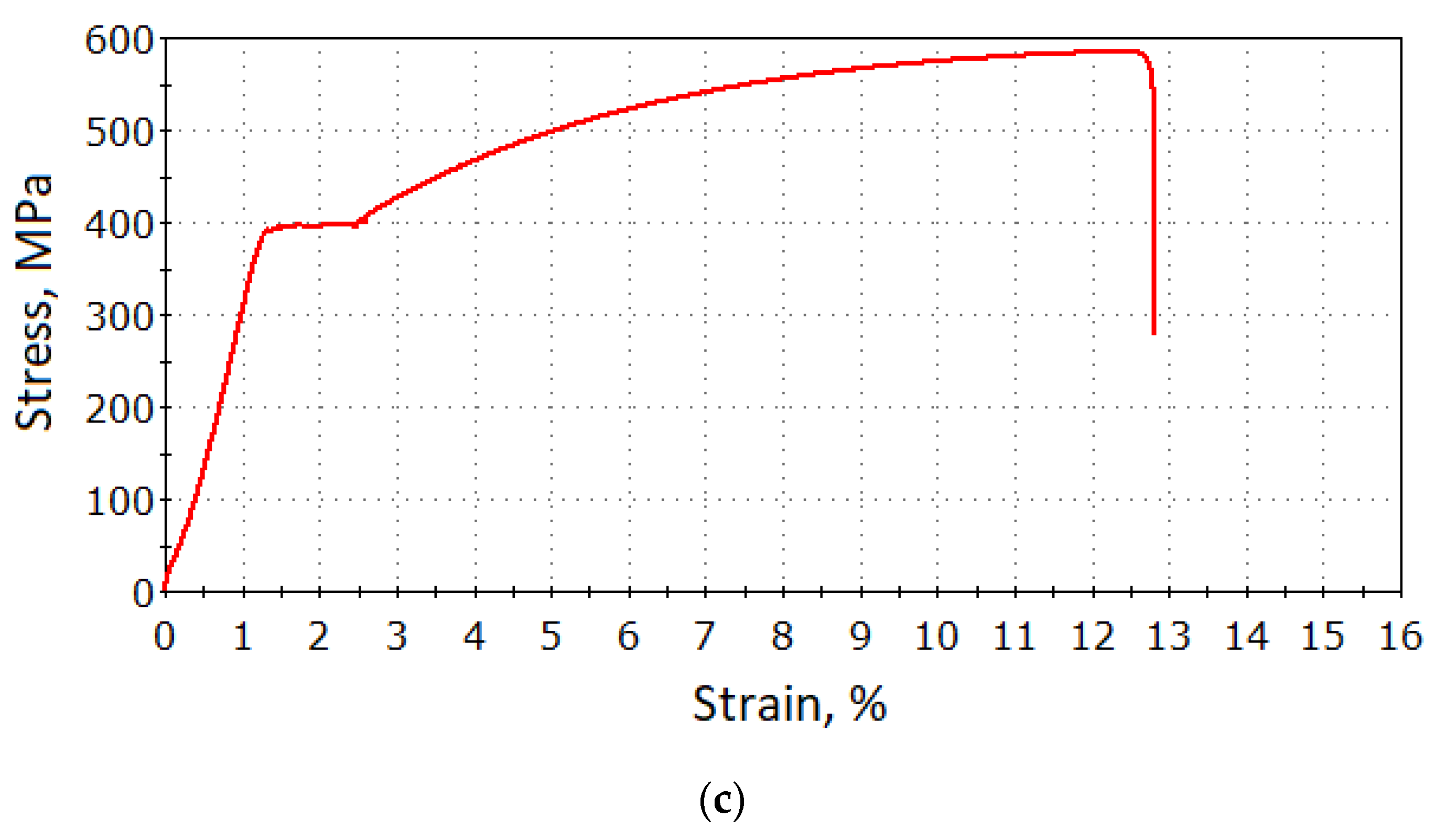
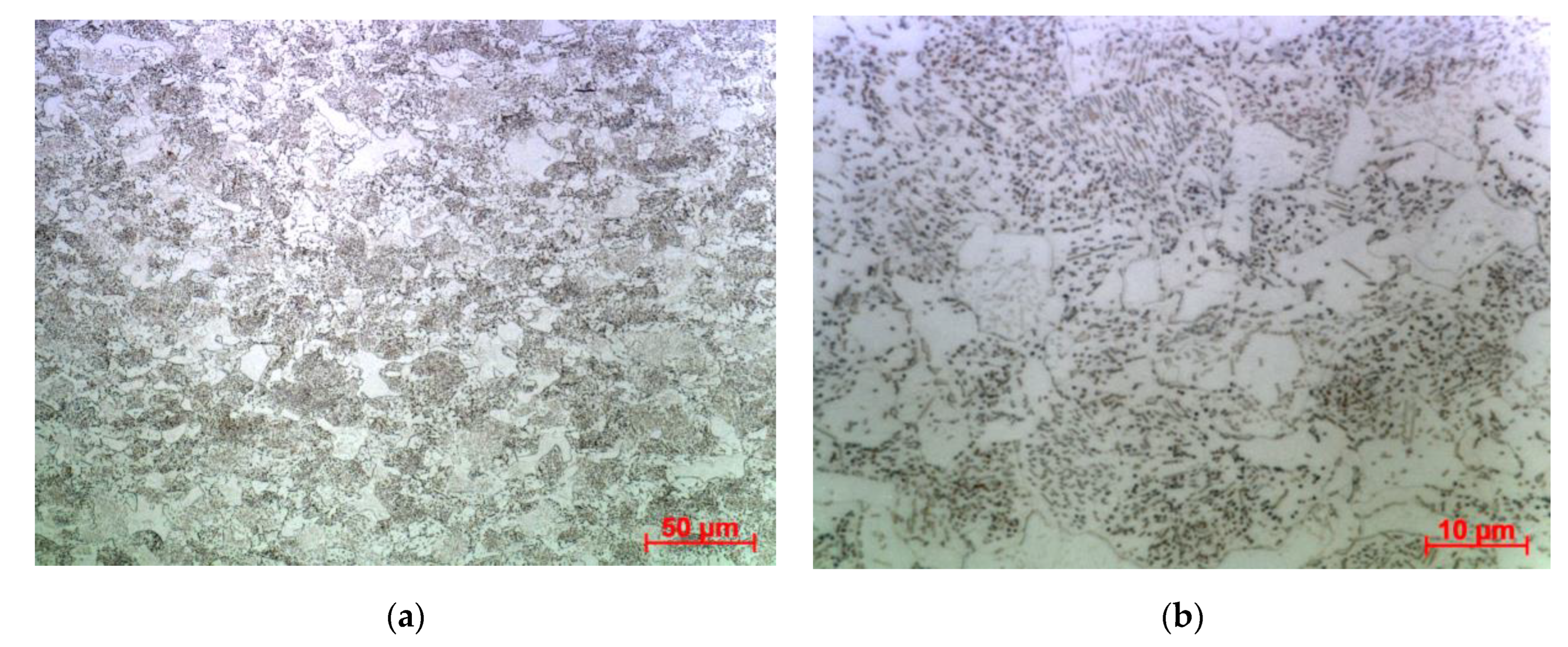

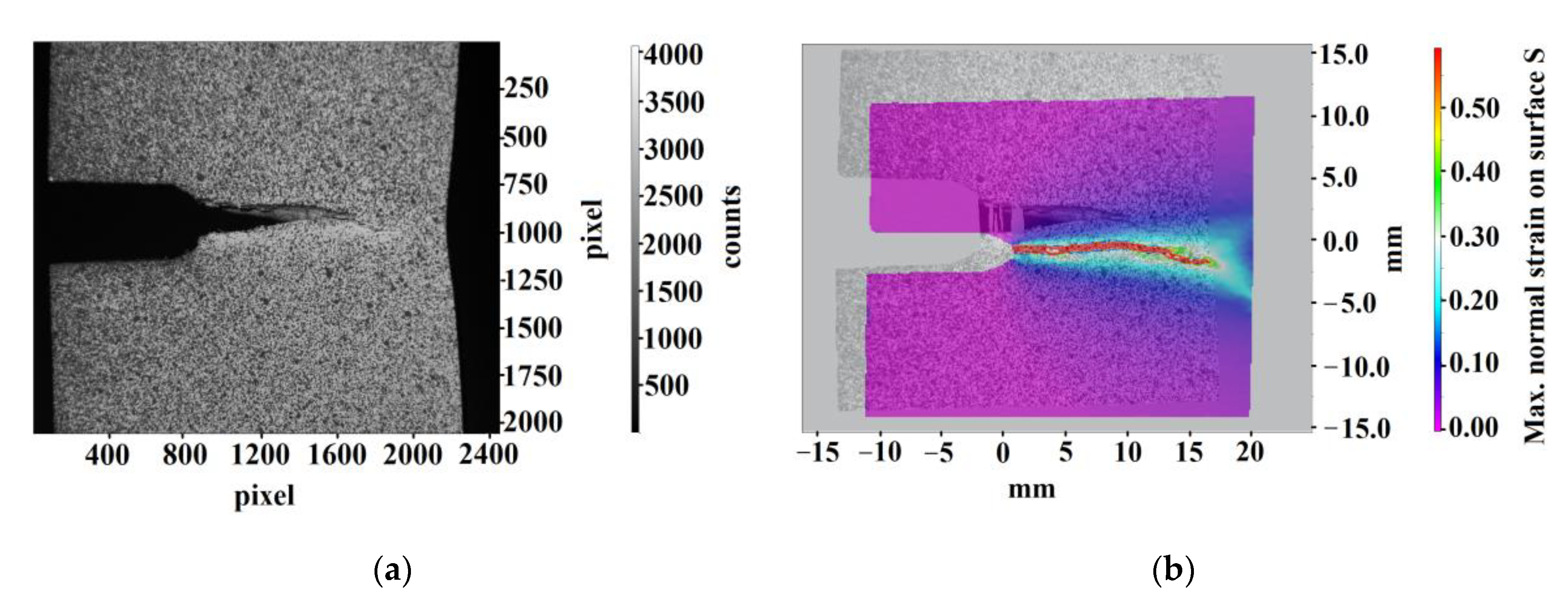

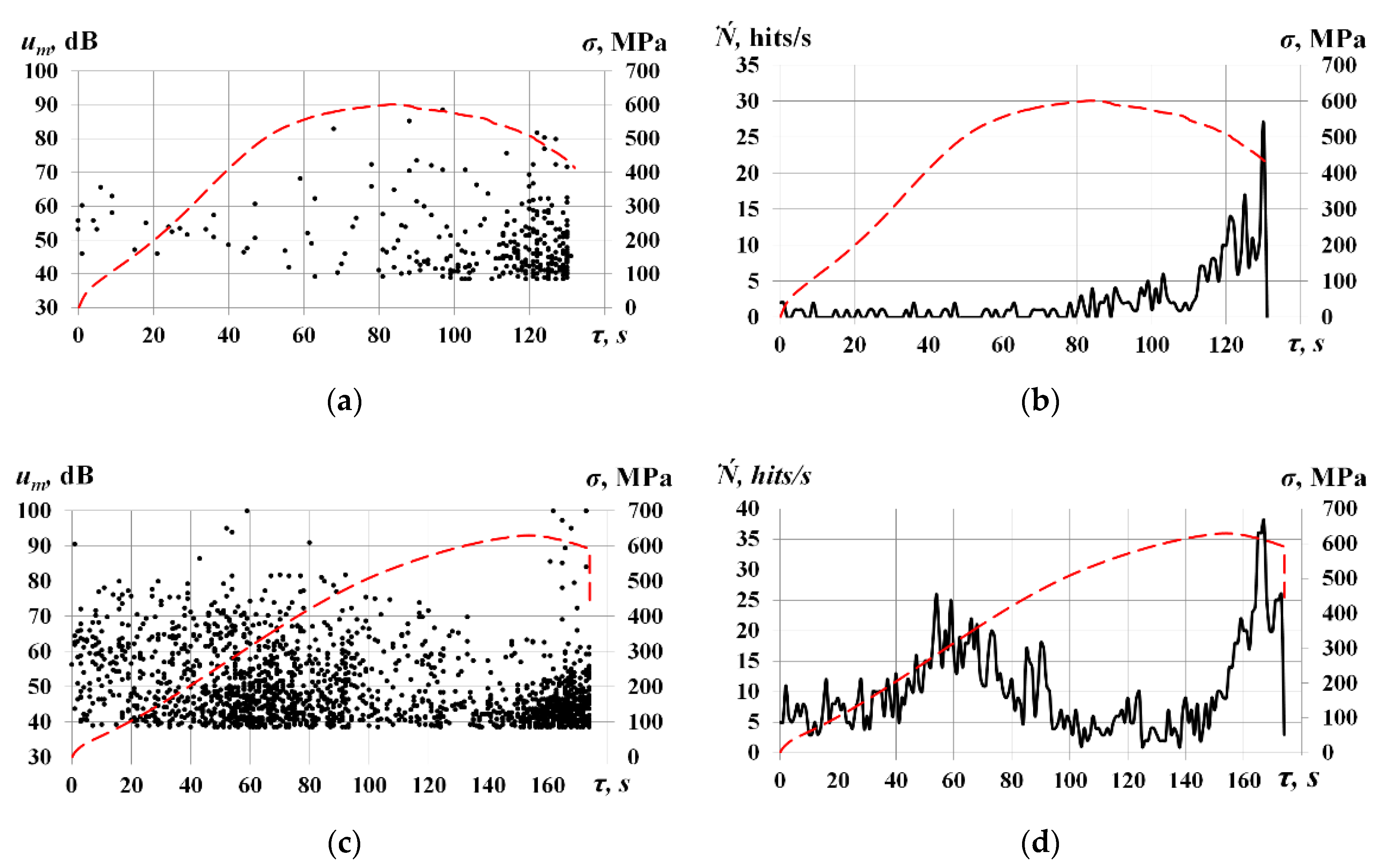

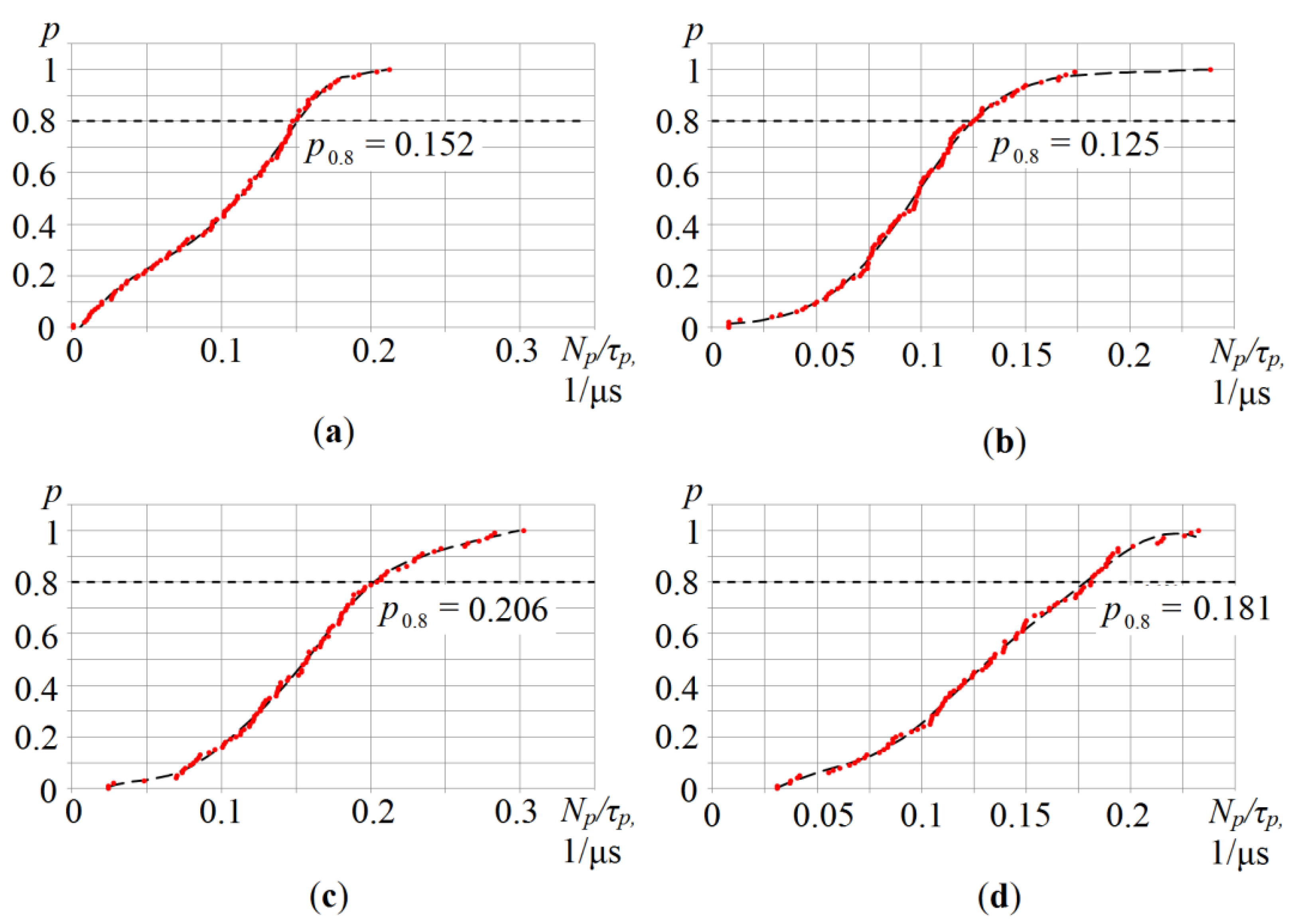
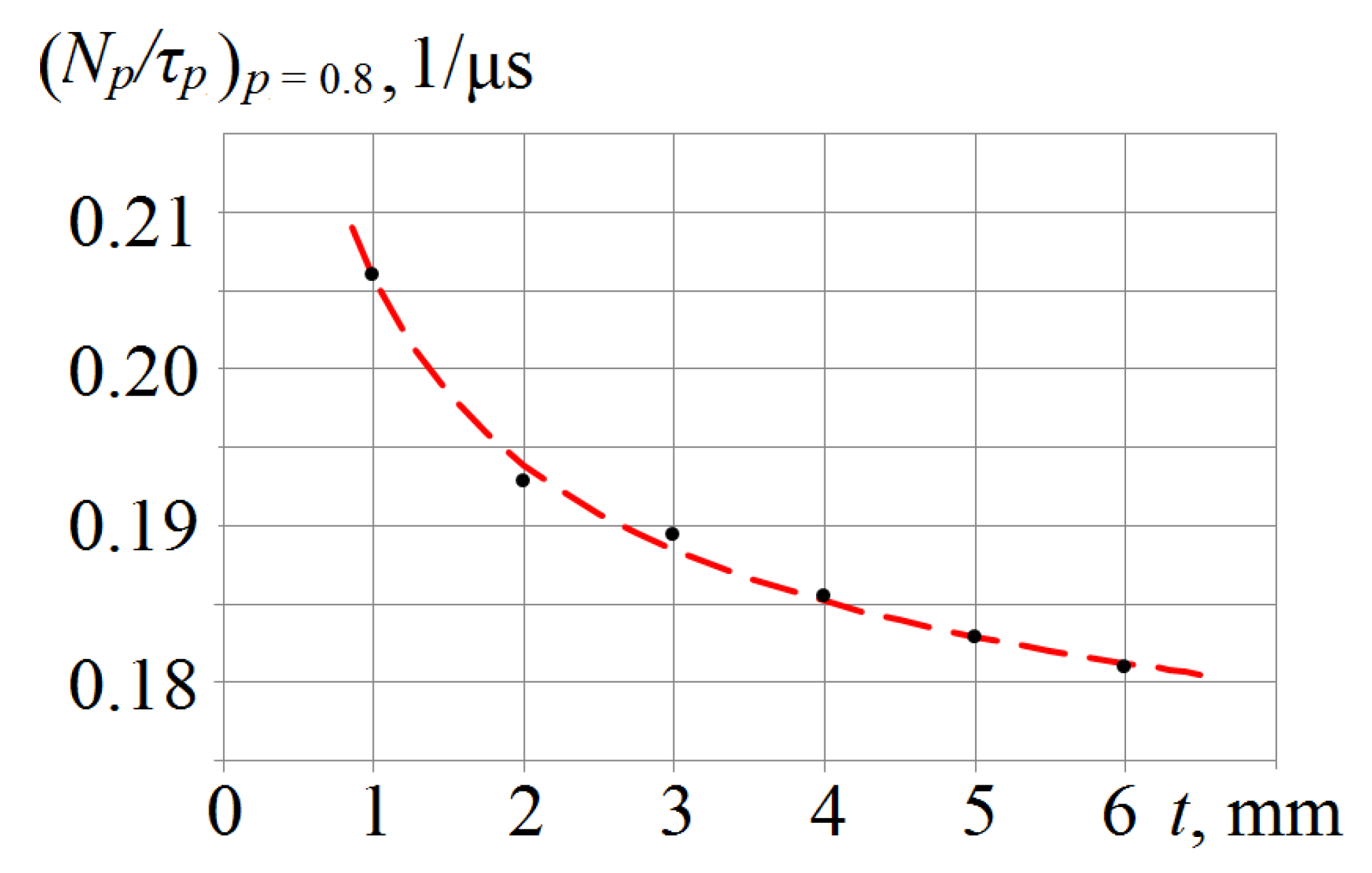

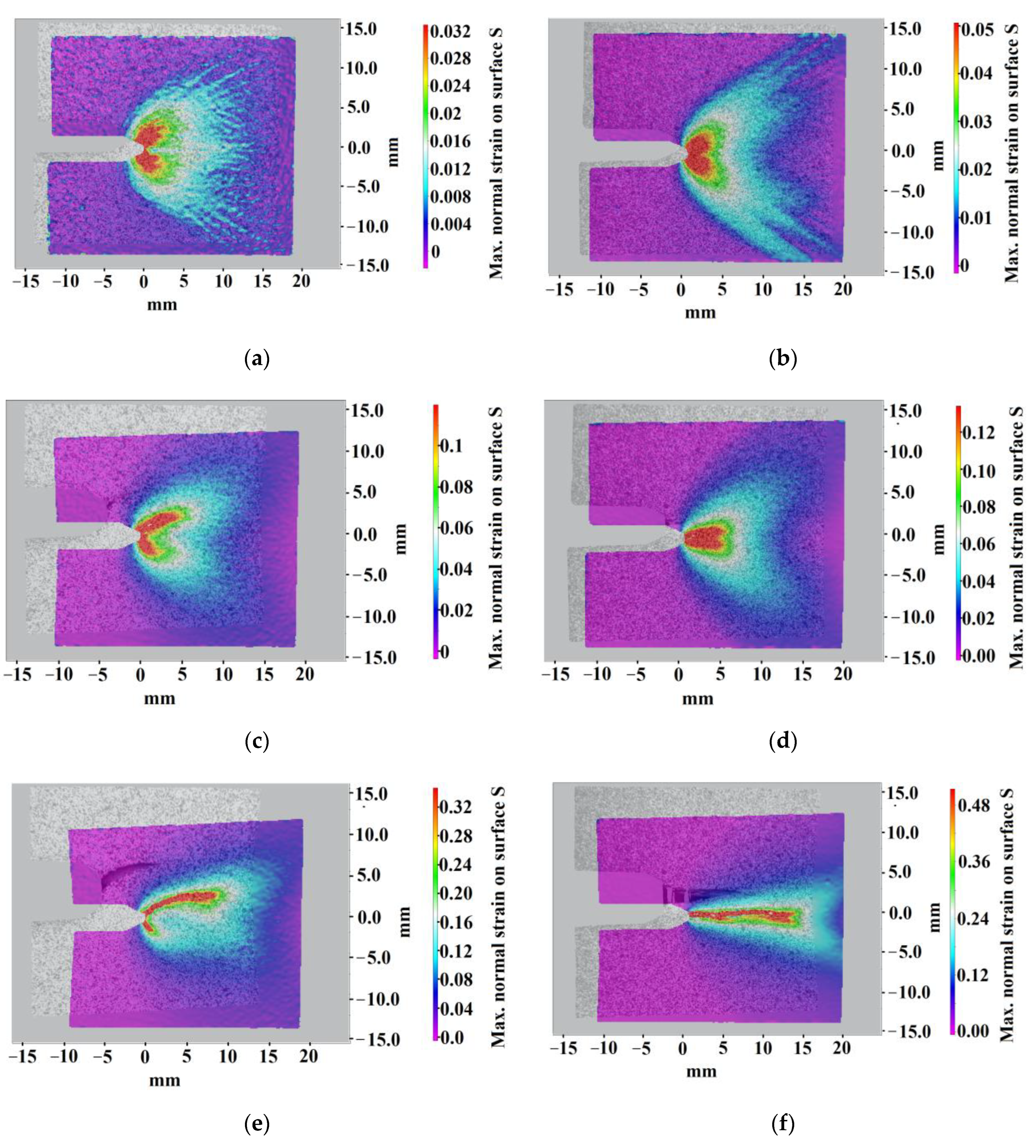

| Element | C | Cr | Mn | Si | Ni | Cu | S | P |
| Content | 0.29 | 1.0 | 1.1 | 0.9 | <0.1 | <0.1 | 0.003 | 0.008 |
| Parameter | Yield Stress σy, MPa | Ultimate Tensile Stress σu, MPa | Uniform Elongation δu, % | Total Elongation δ, % |
|---|---|---|---|---|
| Value range | 388–399 | 584–608 | 10.5–12.7 | 11.0–15.4 |
| Average value | 391 | 599 | 11.5 | 13.5 |
| Specimen Thickness | 1 mm | 6 mm | |||
|---|---|---|---|---|---|
| Parameter | Amplitude um, dB | AE Hits Rate Ń, Hits/s | Amplitude um, dB | AE Hits Rate Ń, Hits/s | |
| Crack length (tensile test stage) | l ≈ 1.7 mm (visible crack appearance) | 68 | 2 | 100 | 26 |
| l ≈ 4.4 mm (crack propagation) | 89 | 6 | 92 | 10 | |
| l ≈ 7–8 mm (acoustic gap) | 65 | 3 | 70 | 6 | |
| l ≈ 9–10 mm (before failure) | 82 | 27 | 100 | 38 | |
Publisher’s Note: MDPI stays neutral with regard to jurisdictional claims in published maps and institutional affiliations. |
© 2022 by the authors. Licensee MDPI, Basel, Switzerland. This article is an open access article distributed under the terms and conditions of the Creative Commons Attribution (CC BY) license (https://creativecommons.org/licenses/by/4.0/).
Share and Cite
Marchenkov, A.; Chernov, D.; Zhgut, D.; Pankina, A.; Rudenko, E.; Poroykov, A.; Kulikova, E.; Kovaleva, T. Investigation of the Scale Factor Impact on the Results of Acoustic Emission Monitoring of the Steel Specimens Tension Process. Appl. Sci. 2022, 12, 8280. https://doi.org/10.3390/app12168280
Marchenkov A, Chernov D, Zhgut D, Pankina A, Rudenko E, Poroykov A, Kulikova E, Kovaleva T. Investigation of the Scale Factor Impact on the Results of Acoustic Emission Monitoring of the Steel Specimens Tension Process. Applied Sciences. 2022; 12(16):8280. https://doi.org/10.3390/app12168280
Chicago/Turabian StyleMarchenkov, Artem, Dmitriy Chernov, Daria Zhgut, Anastasia Pankina, Ekaterina Rudenko, Anton Poroykov, Ekaterina Kulikova, and Tatiana Kovaleva. 2022. "Investigation of the Scale Factor Impact on the Results of Acoustic Emission Monitoring of the Steel Specimens Tension Process" Applied Sciences 12, no. 16: 8280. https://doi.org/10.3390/app12168280
APA StyleMarchenkov, A., Chernov, D., Zhgut, D., Pankina, A., Rudenko, E., Poroykov, A., Kulikova, E., & Kovaleva, T. (2022). Investigation of the Scale Factor Impact on the Results of Acoustic Emission Monitoring of the Steel Specimens Tension Process. Applied Sciences, 12(16), 8280. https://doi.org/10.3390/app12168280






